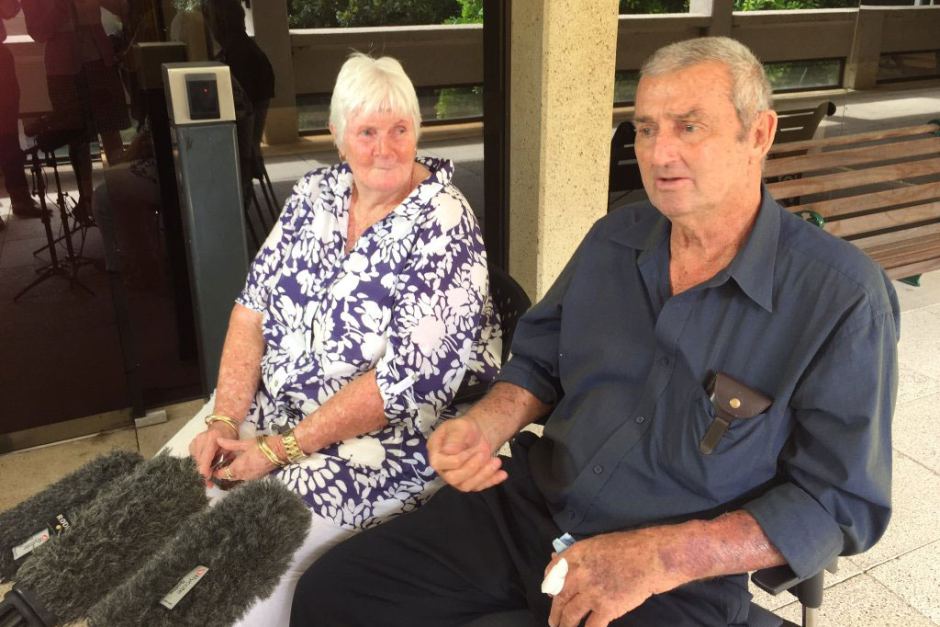Category: Federal - State Issues / Federal Parliament / Occupational Health and Safety / Mining Industry / Coal / Mining Environmental Issues / Mining (Rural) / Work
Ventilation woefully inadequate in mines, black lung hearing told
Monday, 7 Mar 2016 09:31:03

Former coal miner Percy Verrall, with his wife Daphne, told the hearing he was not supplied with masks to protect him from coal dust. (ABC News: Leonie Mellor)
Former coal miners have told a Senate hearing into black lung disease they believe mines have cut corners on protective equipment and maintenance of ventilation systems.
The Senate Select Committee on Health has held the first of its hearings into the re-emergence of pneumoconiosis, a condition also known as black lung or coal miners' disease, which was long thought to have been eradicated.
The committee is sitting in Brisbane today and will sit in Mackay in north Queensland tomorrow.
Six Queensland coal mine workers have recently been diagnosed with the deadly condition, caused by breathing in excessive levels of coal dust, and many more are waiting on medical results.
What is black lung?
Pneumoconiosis is a potentially fatal disease caused by long exposure to coal dust, more commonly known as "black lung" because those with the disease have lungs that look black instead of a healthy pink.Black lung most often stems from working in the coal industry or in the manufacturing of graphite or man-made carbon products and has no known cure.
The risk of getting black lung depends on how much time has been spent around coal dust.
There are two types of black lung: simple and complicated.
There are relatively few symptoms associated with simple black lung, also known as coal worker's pneumoconiosis (CWP), and the prognosis is usually good.
But CWP can progress into the more complicated progressive massive fibrosis (PMF), the symptoms of which may include a long-term cough and shortness of breath.
There is no cure for black lung, but doctors may be able to treat complications caused by the disease.
In 2013, coal worker's pneumoconiosis killed 25,000 people, according to UK medical journal The Lancet.
Source: University of Kentucky, US National Library of Medicine and The Lancet
Percy Verrall, 72, from Ipswich, west of Brisbane, worked for 29 years in Queensland coal mines.
Mr Verrall was the first person in 30 years in Australia to be diagnosed with pneumoconiosis from inhaling coal dust during his years underground.
He told the hearing he was not supplied with masks to protect him from coal dust.
"I don't want to see any other young blokes in that condition," he said.
"It's got to be fixed up so they're not going to get like all the other miners with black lungs.
"They could finish up just the same way as me, or walking around with an oxygen bottle hooked up to them all the time."
Ian Hiscock worked in Queensland coal mines for more than a decade, and told the hearing ventilation was woefully inadequate.
"It's not enough," he said.
"The bane of the coal mine worker at the start of every shift is we always say we want more air, we need more air, and we're not getting it, because the act and regs (regulations) say 'This is what you need to work to' and the companies supply the minimum amount of air. But it's not enough," he said.
Sufferers 'can't walk two or three steps without gasping for breath'
The Construction, Forestry, Mining and Energy Union (CFMEU) earlier raised concerns that a lack of qualified radiologists in Australia meant X-rays were not being properly screened.
The union sent X-rays to the United States to be checked.
But the inquiry heard there were Australian radiologists qualified to detect black lung disease in X-rays.
Dr Richard Slaughter, from the Royal Australian and New Zealand College of Radiologists, said there were 35 specialists in Australia who could perform the task.
CFMEU spokesman Steve Smyth said he hoped the findings of the committee would lead to changes in the coal mining industry, saying screening for black lung was "a disgrace".
"They [mine workers] are actually going through hell," he said.
"Their health is absolutely terrible and they can't walk two or three steps without gasping for breath."
The Queensland Resources Council argued in its submission that the scheme for monitoring the condition was not broken, and urged the inquiry to "be wary of alarmist comments".
The hearing continues in Brisbane.
- About Us
- |
- Terms of Use
- |
-
 RSS
RSS - |
- Privacy Policy
- |
- Contact Us
- |
- Shanghai Call Center: 962288
- |
- Tip-off hotline: 52920043
- 沪ICP证:沪ICP备05050403号-1
- |
- 互联网新闻信息服务许可证:31120180004
- |
- 网络视听许可证:0909346
- |
- 广播电视节目制作许可证:沪字第354号
- |
- 增值电信业务经营许可证:沪B2-20120012
Copyright © 1999- Shanghai Daily. All rights reserved.Preferably viewed with Internet Explorer 8 or newer browsers.




 Send to Kindle
Send to Kindle